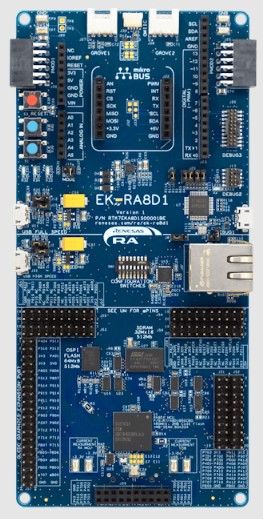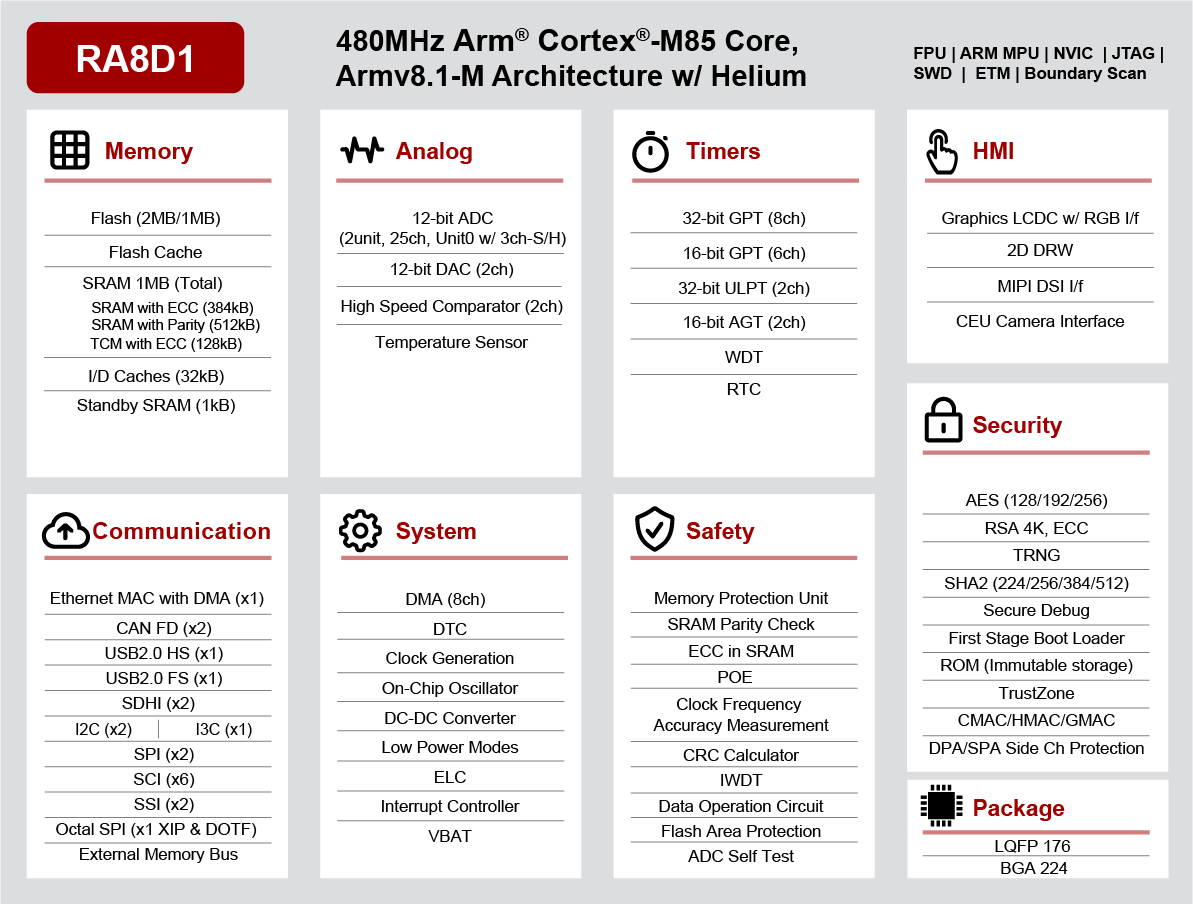RA8D1 Evaluation Kit
Overview
The EK-RA8D1 is an Evaluation Kit for Renesas RA8D1 MCU Group which are the industry’s first 32-bit graphics-enabled MCUs based on the Arm Cortex-M85 (CM85) core, delivering breakthrough performance of over 3000 Coremark points at 480 MHz and superior graphics capabilities that enable high-resolution displays and Vision AI applications.
The key features of the EK-RA8D1 board are categorized in three groups as follow:
MCU Native Pin Access
480MHz Arm Cortex-M85 based RA8D1 MCU in 224 pins, BGA package
Native pin acces througgh 2 x 50-pin, and 2 x 40-pin male headers
MCU current measurement points for precision current consumption measurement
Multiple clock sources - RA8D1 MCU oscillator and sub-clock oscillator crystals, providing precision 20.000MHz and 32,768 Hz refeence clocks. Additional low precision clocks are avaialbe internal to the RA8D1 MCU
System Control and Ecosystem Access
USB Full Speed Host and Device (micro-AB connector)
Four 5V input sources
USB (Debug, Full Speed, High Speed)
External power supply (using surface mount clamp test points and power input vias)
Three Debug modes
Debug on-board (SWD)
Debug in (ETM, SWD and JTAG)
Debug out (SWD)
User LEDs and buttons
Three User LEDs (red, blue, green)
Power LED (white) indicating availability of regulated power
Debug LED (yellow) indicating the debug connection
Two User buttons
One Reset button
Five most popular ecosystems expansions
Two Seeed Grove system (I2C/I3C) connectors
One SparkFun Qwiic connector
Two Digilent Pmod (SPI, UART and I2C/I3C) connectors
Arduino (Uno R3) connector
MikroElektronika mikroBUS connector
MCU boot configuration jumper
Special Feature Access
Ethernet (RJ45 RMII interface)
USB High Speed Host and Device (micro-AB connector)
512 Mb (64 MB) External Octo-SPI Flash (present in the MCU Native Pin Access area of the EK-RA8D1 board)
CAN FD (3-pin header)

EK-RA8D1 Board Functional Area Definitions (Credit: Renesas Electronics Corporation)
Hardware
Detail Hardware feature for the RA8D1 MCU group can be found at RA8D1 Group User’s Manual Hardware

RA8D1 Block diagram (Credit: Renesas Electronics Corporation)
Detail Hardware feature for the EK-RA8D1 MCU can be found at EK-RA8D1 - User’s Manual
Supported Features
The below features are currently supported on Zephyr OS for EK-RA8D1 board:
Interface |
Controller |
Driver/Component |
|---|---|---|
GPIO |
on-chip |
gpio |
MPU |
on-chip |
arch/arm |
NVIC |
on-chip |
arch/arm |
UART |
on-chip |
serial |
CLOCK |
on-chip |
clock control |
ENTROPY |
on-chip |
entropy |
SPI |
on-chip |
spi |
FLASH |
on-chip |
flash |
Other hardware features are currently not supported by the port.
Programming and Debugging
Applications for the ek_ra8d1 board configuration can be
built, flashed, and debugged in the usual way. See
Building an Application and Run an Application for more details on
building and running.
Note: Only support from SDK v0.16.6 in which GCC for Cortex Arm-M85 was available. To build for EK-RA8M1 user need to get and install GNU Arm Embedded toolchain from https://github.com/zephyrproject-rtos/sdk-ng/releases/tag/v0.16.6
Flashing
Program can be flashed to EK-RA8D1 via the on-board SEGGER J-Link debugger. SEGGER J-link’s drivers are avaialbe at https://www.segger.com/downloads/jlink/
To flash the program to board
Connect to J-Link OB via USB port to host PC
Make sure J-Link OB jumper is in default configuration as describe in EK-RA8D1 - User’s Manual
Execute west command
west flash -r jlink
Debugging
You can use Segger Ozone (Segger Ozone Download) for a visual debug interface
Once downloaded and installed, open Segger Ozone and configure the debug project like so:
Target Device: R7FA8D1BH
Target Interface: SWD
Target Interface Speed: 4 MHz
Host Interface: USB
Program File: <path/to/your/build/zephyr.elf>
Note: It’s verified that debug is OK on Segger Ozone v3.30d so please use this or later version of Segger Ozone
